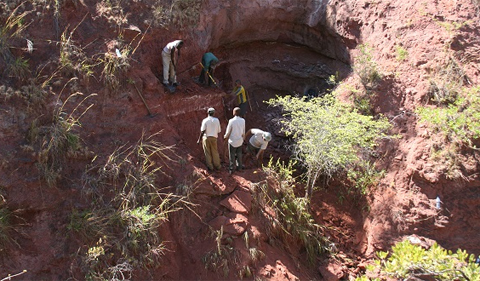
An artistic rendering of a deceased Rukwatitan bisepultus individual in the initial floodplain depositional setting from which the holotypic skeleton was recovered. Image credit: Mark Witton, University of Portsmouth.
Eric Gorscak ’09, a doctoral student in Biological Sciences, is the lead author on the discovery of a new species of titanosaurian dinosaur in Tanzania.
The study describes a rare find—a sauropod dinosaur skeleton from Africa.
Ohio University paleontologists have identified the new species of titanosaurian, a member of the large-bodied sauropods that thrived during the final period of the dinosaur age, in Tanzania. Although many fossils of titanosaurians have been discovered around the globe, especially in South America, few have been recovered from the continent of Africa.
The new species, named Rukwatitan bisepultus, was first spotted by scientists embedded in a cliff wall in the Rukwa Rift Basin of southwestern Tanzania. Using the help of professional excavators and coal miners, the team unearthed vertebrae, ribs, limbs and pelvic bones over the course of two field seasons.
CT scans of the fossils, combined with detailed comparisons with other sauropods, revealed unique features that suggested an animal that was different from previous finds—including those from elsewhere in Africa, according to a study the team published today in the Journal of Vertebrate Paleontology.
“Using both traditional and new computational approaches, we were able to place the new species within the family tree of sauropod dinosaurs and determine both its uniqueness as a species and to delineate others species with which it is most closely related,” said Gorscak, who is an Ohio University alum, having earned a B.S. in Biological Sciences in 2009.

Eric Gorscak, lead author on the new study, is a Cambridge, Ohio, native who is a doctoral student in biological sciences at Ohio University. Photo: Emily R. Naylor/Courtesy of Eric Gorscak
An Herbivore Weighing as Much as Several Elephants
Rukwatitan bisepultus lived approximately 100 million years ago during the middle of the Cretaceous Period. Titanosaurian sauropods, the group that includes Rukwatitan, were herbivorous dinosaurs known for their iconic large body sizes, long necks and wide stance. Although not among the largest of titanosaurians, Rukwatitan is estimated to have a forelimb reaching 2 meters and may have weighed as much as several elephants.
The dinosaur’s bones exhibit similarities with another titanosaurian, Malawisaurus dixeyi, previously recovered in Malawi. But the two southern African dinosaurs are distinctly different from one another, and, most notably, from titanosaurians known from northern Africa, said co-author Dr. Patrick O’Connor, Professor of Anatomy in the Ohio University Heritage College of Osteopathic Medicine.
The fossils of middle Cretaceous crocodile relatives from the Rukwa Rift Basin also exhibit distinctive features when compared to forms from elsewhere on the continent.
“There may have been certain environmental features, such as deserts, large waterways and/or mountain ranges, that would have limited the movement of animals and promoted the evolution of regionally distinct faunas,” O’Connor said. “Only additional data on the faunas and paleo environments from around the continent will let us further test such hypotheses.”

This image shows the pieces of the skeleton recovered of Rukwatitan bisepultus within a silhouette of the animal. The bar equals 1 meter. Image credit: Eric Gorscak, Ohio University.
Watch a National Science Foundation video of the story.
Filling in Evolutionary History
In addition to providing new data about species evolution in sub-Saharan Africa, the study also contributes to fleshing out the global portrait of titanosaurians, which lived in habitats across the globe through the end of the Cretaceous Period. Their rise in diversity came in the wake of the decline of another group of sauropods, the diplodocoids, which include the dinosaur Apatosaurus, the researchers noted. Scientists have found fossils for more than 30 titanosaurians in South America compared to just four in Africa.
“Much of what we know regarding titanosaurian evolutionary history stems from numerous discoveries in South America—a continent that underwent a steady separation from Africa during the first half of the Cretaceous Period,” Gorscak said. “With the discovery of Rukwatitan and study of the material in nearby Malawi, we are beginning to fill a significant gap from a large part of the world.”
Co-authors on the study are Dr. Nancy Stevens, a professor in the Ohio University Heritage College of Osteopathic Medicine, and Eric Roberts, a senior lecturer in the James Cook University of Australia.
The study was funded by the National Science Foundation, the National Geographic Society, the Ohio University Heritage College of Osteopathic Medicine and the Ohio University Office of the Vice President for Research and Creative Activity.




















Comments